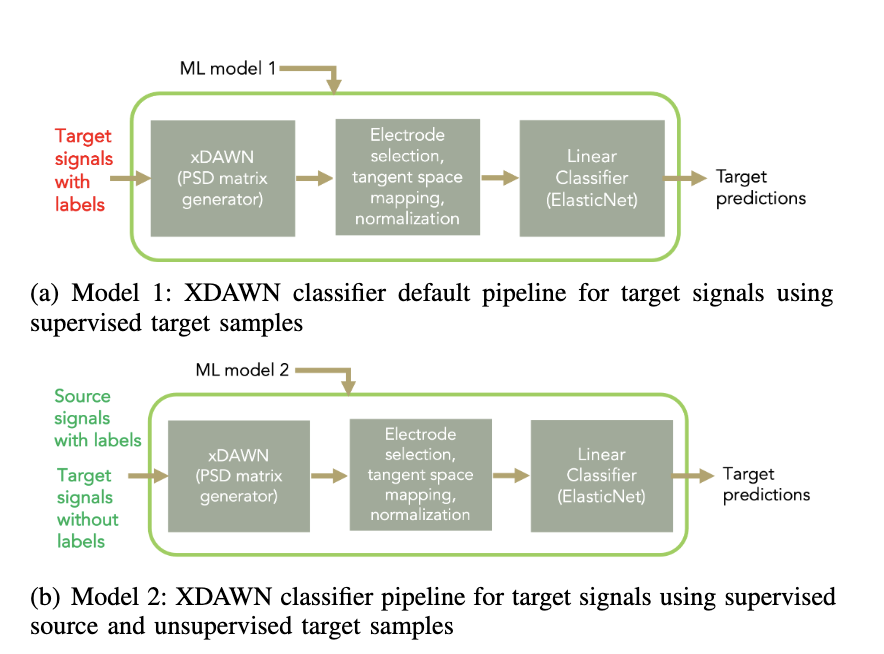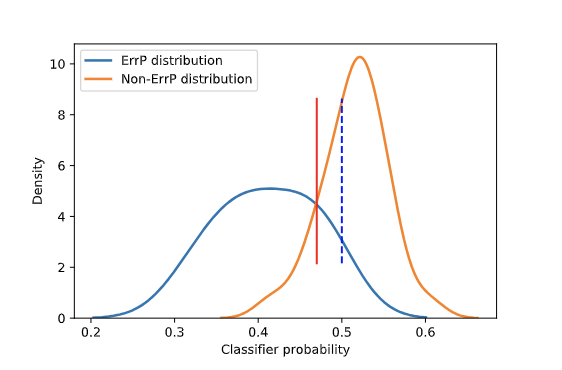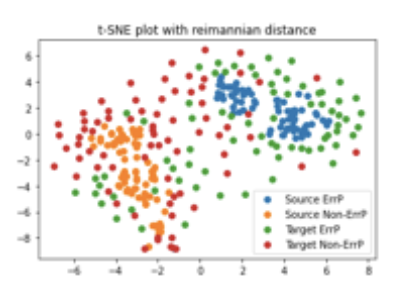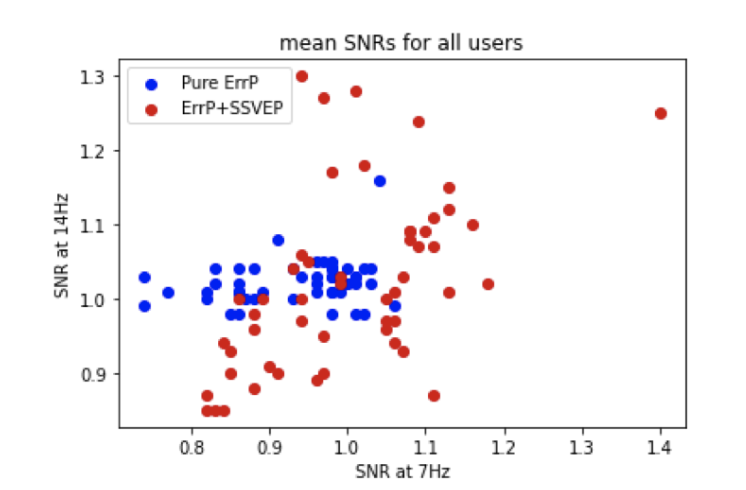GNAN Lab @ Georgia Tech
Brain Computer Interfaces Research
The objective of the proposed research is to address some of the fundamental challenges in Brain-Computer Interface (BCI) systems. Brain-computer interfaces have surfaced as a powerful and attractive modality in human-machine interaction. BCIs establish a channel for communicating with machines directly, bypassing the physical constraints and limi- tations of the body. However, EEG-based non-invasive BCIs also suffer from 2 fundamental challenges, among other problems. Firstly, since they measure the electrical activity in the brain externally on the scalp, it significantly reduces the signal-to-noise ratio. This leads to low detection accuracy and poor performance by classification models. Secondly, BCI signals do not generalize well across other individuals owing to a high amount of signal variability between subjects. This makes it extremely difficult to re-use a machine learning model built by using one user’s data on others and requires tedious re-training on new users. In our lab research, we work with brain-computer Interfaces along three research thrusts, namely, transfer learning for BCIs, approaches to enhance detection for low SNR BCI signals, and exploring futuristic applications using BCIs which dovetail seamlessly with an increasingly connected world. We outline our 3 research thrusts as follows:
Research Thrusts
1. Transfer Learning for Brain-Computer Interfaces
We primarily look at the Error Potential signal (ErrP) for this thrust, a signal known for its poor generalization. In this work, we present a method that not only shrinks
the re-calibration overhead for this signal to a tiny fraction of the original but
also provides a generalization accuracy that approaches that of
intra-user models. We use transfer learning to transfer relevant
parts of our detection model using divergence calculations in the
signal probability space and use few-shot learning to adapt the
model to a new user. We demonstrate our method on a dataset
collected in our lab and obtain state-of-the-art results. Ekansh Gupta, Mohit Agarwal and Raghupathy Sivakumar Ekansh Gupta and Raghupathy Sivakumar
In our more recent work, we
overview the factors contributing to poor generalization on
a more granular level and propose a
novel algorithm to mitigate the associated covariate shift in the probability space using partial target-aware optimal transport. We demonstrate
our method on an ErrP dataset collected in our lab. Our
method outperforms state-of-the-art models for cross-user
generalization which translates to a reduction in calibration
time by an order of magnitude.
Ekansh Gupta, Cheng-Yeh Chen, Raghupathy Sivakumar Our continuing research is focussed on improving the separability of unsupervised EEG embeddings and optimally adapting them from source to target spaces. While brain signals
like the error potential (ErrP) showcase low SNR and have
lower detection accuracy, there are other kinds of signals that
showcase high detection rates and resilience to noise. Motivated
by this disparity, we ask ourselves if the abstract cognitive states
involved in the evocation of such resilient signals be leveraged
to amplify or augment the weaker signals, and thus provide
them a performance boost. We investigate this hypothesis by
designing an experiment to interface these two kinds of signals
and collect EEG data in our lab through human trials. We
evaluate our hypothesis and contrast our results with other
datasets of isolated signals using spatial filtering and deep
learning models. We obtain negative results and reflect on the
insights and the lessons learned based on them and talk about
plausible explanations and future work while also reassessing
our initial hypothesis
Ekansh Gupta, Cheng-Yeh Chen and Raghupathy Sivakumar Our continuing research is focused on leveraging the characteristics of easily-detectable signals to aid in the detection of low SNR signals. As BCIs help us gauge user intent without needing explicit communication, they can be helpful for human-aided or human-in-the-loop systems that enhancing the performance of AI agents. We outline our work where we used implicit user feedback using BCIs to accelerate RL agents. Duo Xu, Mohit Agarwal, Ekansh Gupta, Faramarz Fekri, and Raghupathy Sivakumar We also explored the implicit security offered by brain signals in applications like authentication and leveraged the highly individualistic signals like eye-blinks to design an authentication system. we specifically focused on the EEG signal corresponding to the human eye-blink to create an authentication system that
could be used to distinguish between multiple users accurately
and efficiently while also being burden-less and convenient to the
users. We use a dataset of eye-blink related EEG signals, collected
from 20 users, to study our solution. Our results show that blink
signals can be used for accurately distinguishing between different
users and hence can be used for authentication. Ekansh Gupta, Mohit Agarwal, and Raghupathy Sivakumar 
"Transfer Learning for Brain-Computer Interfaces in Cyber-Physical Systems ,"
2023 IEEE International Conference on Advanced Networks and Telecommunications Systems (ANTS 2023)
"Wisdom of the Crowd: Using Multi-human Few-shot Learning to Improve Cross- User Generalization for Error Potentials in BCI Systems",
2022 International Joint Conference on Neural Networks (IJCNN), Padua, Italy, 2022, pp. 1-8.
"Hyper-Accelerated Learning for Brain-Computer Interfaces via Partial Target-Aware Optimal Transport ,"
Proceedings of the 2nd Workshop on Smart Wearable Systems and Applications (SmartWear 2023)2. Improving signal detection using Amplification/Modulation

"Do Weak Brain Signals Get Amplified When Strong Brain Signals are Evoked?,"
Third International Workshop on Negative Results in Pervasive Computing (PerFail 2024)3. Transformative BCI applications to aid ML models and humans
Providing Reinforcement Learning (RL) agents with
human feedback can dramatically improve various aspects of
learning. However, previous methods require human observer
to give inputs explicitly (e.g., press buttons, voice interface),
burdening the human in the loop of RL agent’s learning process.
Further, providing explicit human advise (feedback) continuously
is not always possible or too restrictive, e.g., autonomous driving,
disabled rehabilitation, etc. In this work, we investigate capturing
human’s intrinsic reactions as implicit (and natural) feedback
through EEG in the form of error-related potentials (ErrP),
providing a natural and direct way for humans to improve the RL
agent learning. As such, the human intelligence can be integrated
via implicit feedback with RL algorithms to accelerate the
learning of RL agent. We develop three reasonably complex 2D
discrete navigational games to experimentally evaluate the overall
performance of the proposed work. And the motivation of using
ErrPs as feedbacks is also verified by subjective experiments.
Major contributions of our work are as follows, (i) we propose
and experimentally validate the zero-shot learning of ErrPs,
where the ErrPs can be learned for one game, and transferred to
other unseen games, (ii) we propose a novel RL framework for
integrating implicit human feedbacks via ErrPs with RL agent,
improving the label efficiency and robustness to human mistakes,
and (iii) compared to prior works, we scale the application of
ErrPs to reasonably complex environments, and demonstrate the
significance of our approach for accelerated learning through real
user experiments

"Accelerating Reinforcement Learning using EEG-based Implicit Human Feedback",
Neurocomputing, Elsevier - 2021.
"Blink to Get In: Biometric Authentication for Mobile Devices using EEG Signals,,"
IEEE International Conference on Communications, ICC, 2020.

